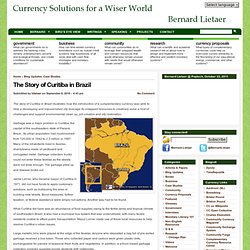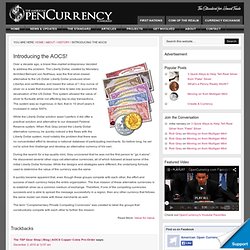

Complementary Currency Resource Center. Welcome to the Community Exchange System. Bitcoin. Decentralized cryptocurrency Bitcoin (₿) is a cryptocurrency, a form of electronic cash.

It is a decentralized digital currency without a central bank or single administrator that can be sent from user to user on the peer-to-peer bitcoin network without the need for intermediaries.[8] Bitcoin has been criticized for its use in illegal transactions, its high electricity consumption, price volatility, thefts from exchanges, and the possibility that bitcoin is an economic bubble.[14] Bitcoin has also been used as an investment, although several regulatory agencies have issued investor alerts about bitcoin.[15] History Creation On 3 January 2009, the bitcoin network was created when Nakamoto mined the first block of the chain, known as the genesis block.[20][21] Embedded in the coinbase of this block was the following text: "The Times 03/Jan/2009 Chancellor on brink of second bailout for banks In 2011, the price started at $0.30 per bitcoin, growing to $5.27 for the year.
Design Units Blockchain. The Story of Curitiba in Brazil. The story of Curitiba in Brazil illustrates how the introduction of a complementary currency was able to help a developing and impoverished city leverage its untapped resources to creatively solve a host of challenges and support environmental clean up, job creation and city restoration.

Garbage was a major problem in Curitiba, the capital of the southeastern state of Paraná, Brazil. Its urban population had mushroomed from 120,000 in 1942 to 2.3 million in 1997. Many of the inhabitants lived in favelas, shantytowns made of cardboard and corrugated metal. Garbage collection trucks could not enter these favelas as the streets were not wide enough. The garbage piled up and disease broke out. Jaime Lerner, who became mayor of Curitiba in 1971, did not have funds to apply customary solutions, such as bulldozing the area or building new streets. What Curitiba did have was an abundance of food supplies owing to the fertile lands and tropical climate of southeastern Brazil. Like this: Introducing the AOCS! — The American Open Currency Standard. Over a decade ago, a brave free-market entrepreneur decided to address the problem.

The Liberty Dollar, created by Monetary Architect Bernard von NotHaus, was the first silver-based alternative to the US Dollar. Liberty Dollar produced silver Libertys and certificates, and based the value of 1 troy ounce of silver on a scale that evolved over time to take into account the devaluation of the US Dollar.
This system allowed the value of silver to fluctuate while not affecting day-to-day transactions. The system was so ingenious, in fact, that in 10 short years it increased in value 500%. While the Liberty Dollar solution wasn’t perfect, it did offer a practical solution and alternative to our diseased Federal Reserve system. During the search for a top-quality mint, Gray uncovered that he was not the first person to “go it alone”. It quickly became apparent that, even though these groups compete with each other, the effort and success of each currency helps the entire organization.
So you want to invent your own currency – Brett Scott. I don’t have much money.

Then again, I couldn’t say exactly how much I do have. In the Co‑operative Bank’s IT system is a database entry that says I have £97 in electronic money. In my wallet I have three £10 notes, pieces of paper with pictures of the Queen on them, issued by the Bank of England, promising me £30. I have six pieces of metal, too — copper-nickel alloy and nickel-plated steel, to be exact — valued at 59 pence in total. So that’s £127.59. My wallet also contains a £5 Brixton Pound note — a local currency found only in the south London neighbourhood where I live — which I got as change from a local bar called Kaff. That’s not all. I, too, was once a counterfeit of sorts. How can a piece of paper store 10 pounds of value? The trouble is, while my experiences in mainstream finance taught me a lot about what the industry does, they only gave me glimpses into the nature of the mysterious stuff it does it with.
Most people never get this opportunity. Why do I do it?